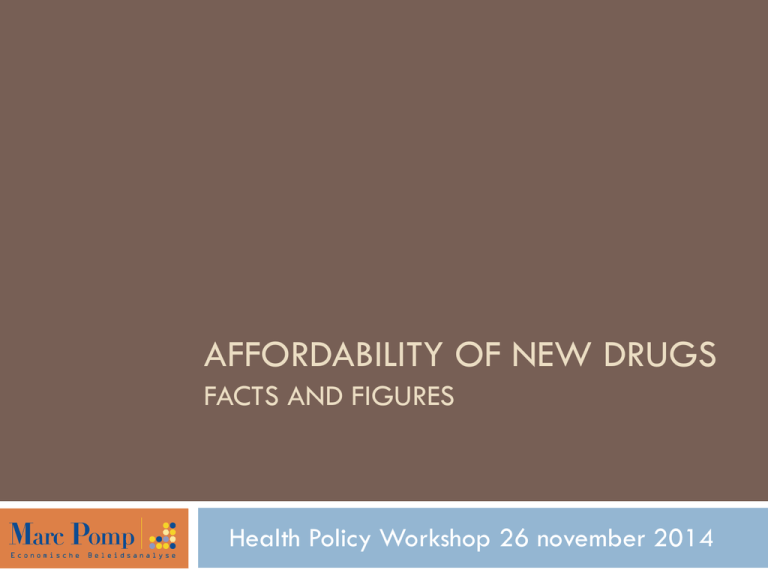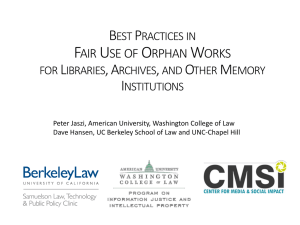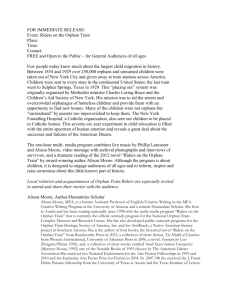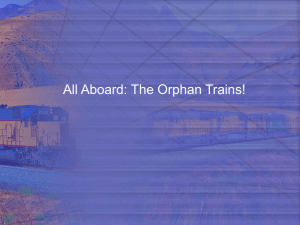AFFORDABILITY OF NEW DRUGS FACTS AND FIGURES
advertisement

AFFORDABILITY OF NEW DRUGS FACTS AND FIGURES Health Policy Workshop 26 november 2014 Outline What do we spend on orphan drugs and other expensive drugs? What is “affordable”? What do we know about prices? What is in the pipeline? Uptake and budget impact of orphan drugs in the Netherlands 2006 2007 2008 2009 2010 Number of orphan drugs Total 11 22 26 31 36 Number of patients treated with orphan drugs Total 2,189 3,603 4,625 6,493 8,152 Budget impact of orphan drugs (millions) Total €61.2 €97.9 €158.6 €192.7 €225.9 2011 2012 41 43 8,786 9,762 €241.4 €260.4 Spending on new cancer drugs much higher than on orphan drugs KWF, Toegankelijkheid van dure kankergeneesmiddelen, Nu en in de toekomst, Signaleringscommissie Kanker van KWF Kankerbestrijding, 2014 Spending on other ‘expensive’ drugs (non orphan) Bron: http://www.geneesmiddelendebat.nl/docs/Mijn%20documenten/afbeeldingen/Cijfers/Berekening_kosten_Dure_Geneesmiddelen.pdf The 1000$ a day pill Hepatitis C The 1000$ a day pill Hepatitis C About $90 000 for a full course Currently available for ~1000 patients in NL Potentially ~100 000 patients in NL Would cost ~ euro 7 billion… Outline What do we spend on orphan drugs and other expensive drugs? What is “affordable”? What do we know about prices? What is in the pipeline? What is affordable? Ability to pay? Type of drug Rough estimate costs (2014), € million Orphan drugs 300 Other ‘expensive drugs’* 1,200 * > 10 000 euro pppy = 2% of total health spending (publicly financed 70 billion euro) What is affordable? Social and payer perspectives Drug spending outside hospitals Drug spending in hospitals What is affordable? From a social perspective Willingness to pay for additionale life year? Literature: value of a QALY (quality adjusted life year), value of statistical life (year) Estimates € 40 000 – € 120 000 Statistical vs identifiable life year Ethical norms: rule of rescue See Dijkgraaf later today Outline What do we spend on orphan drugs and other expensive drugs? What is “affordable”? What do we know about prices? What is in the pipeline? “…the cost of the new generation of drugs is getting out of all proportion to the added benefit.” (Cavalli 2013). Cavalli, Franco. 2013. “An Appeal to World Leaders: Stop Cancer Now.” The Lancet 381(9865): 425-6. Caveat: list price ≠ net price http://www.imsconsultinggroup.com/deployedfiles/consulting/Global/Content/Our%20Latest%20Thinking/Recent%20Topics/Q3%202013 %20IMSCG%20PMA%202013%20A0%20Price%20of%20Innovative%20Oncology.pdf Berndt et al., Pricing in the Market for Anticancer Drugs, Prices in the US, MIT working paper August 29, 2014 prices converted to 2013 price level $120 000 Not sure that this translates to the Dutch situation.. price new cancer drugs per life year gained < 65 000 euro Source: Volkskrant, 20 11 2013 Some (most?) orphan drugs above 120 000 threshold But (some of?) these drugs save identifiable lifes Orphan drugs with highest number of highest budget impact (2012) RankTrade name 1 Glivec® 2 Revlimid® 3 Revatio® 4 Thalidomide Cellgene® 5 Tracleer® RankTrade name 1 Naglazyme® 1 Elaprase® 3 Myzoyme® 4 Soliris® 5 Laronidase® RankTrade name 1 Myozyme® 2 Glivec® 3 Revlimid® 4 Tracleer® 5 Somavert® users, highest prices and Patients 1,485 1,089 1,052 1,030 901 Cost/Patient €600,000 €600,000 €474,857* €358,000 €300,000 Budget impact (millions) €40.3 €36.4 €36.2 €23.0 €14.3 Outline What do we spend on orphan drugs and other expensive drugs? What is “affordable”? What do we know about prices? What is in the pipeline? What is in the pipeline? Hirsch, B. R. et al., (2014), The Impact Of Specialty Pharmaceuticals As Drivers Of Health Care Costs. Health Affairs, 33(10), 1714-1720. Predicted total spending growth on pharmaceuticals Bron:: Orphan Drugs in Development for Rare Diseases, Phrma 2011 Future budget impact orphan drugs unknown “To predict the future budget impact of orphan drugs in the Netherlands, detailed information is needed on availability of individual orphan drugs in the Netherlands, number of patients using these drugs, and prices of orphan drugs in the Netherlands, also in relation to generic competition for orphan drugs. This information is yet unavailable for the Netherlands. Further research on these aspects is needed before a prediction of the future budget impact of orphan drugs in the Netherlands can be made.” Projections for France and Sweden OMP budget impact as percentage of total pharmaceutical market: observed and predicted data. Hutchings et al. Orphanet Journal of Rare Diseases 2014 9:22 1750-1172-9-22 Generic competition for biologicals? Biosimilars cost $100– $200 million to develop and take 8–10 years to produce. In comparison, generic medications cost $1–$5 million to develop and take 3–5 years to produce. “Because of the cost and complexity of biosimilar development and production, it is expected that biosimilars will be discounted 20–40 percent from the brand-name product. In contrast, the FDA estimates that generic small molecules are discounted 80–85 percent from the brand-name products with which they compete. Bron: Bradford R. Hirsch, Suresh Balu, and Kevin A. Schulman, Spending On Specialty Pharmaceuticals: The Impact Of Specialty Pharmaceuticals As Drivers Of Health Care Costs, Health Aff October 2014 33:101714-1720 Prices fall after patent expiration D. Lakdawalla, T. Philipson, Y. Wang Intellectual Property And Marketing , NBER Working Paper 12577, 2006 Prices should fall after patent expiration but probably to a lesser extent for large molecules Hirsch, B. R. et al., (2014), The Impact Of Specialty Pharmaceuticals As Drivers Of Health Care Costs. Health Affairs, 33(10), 1714-1720.




